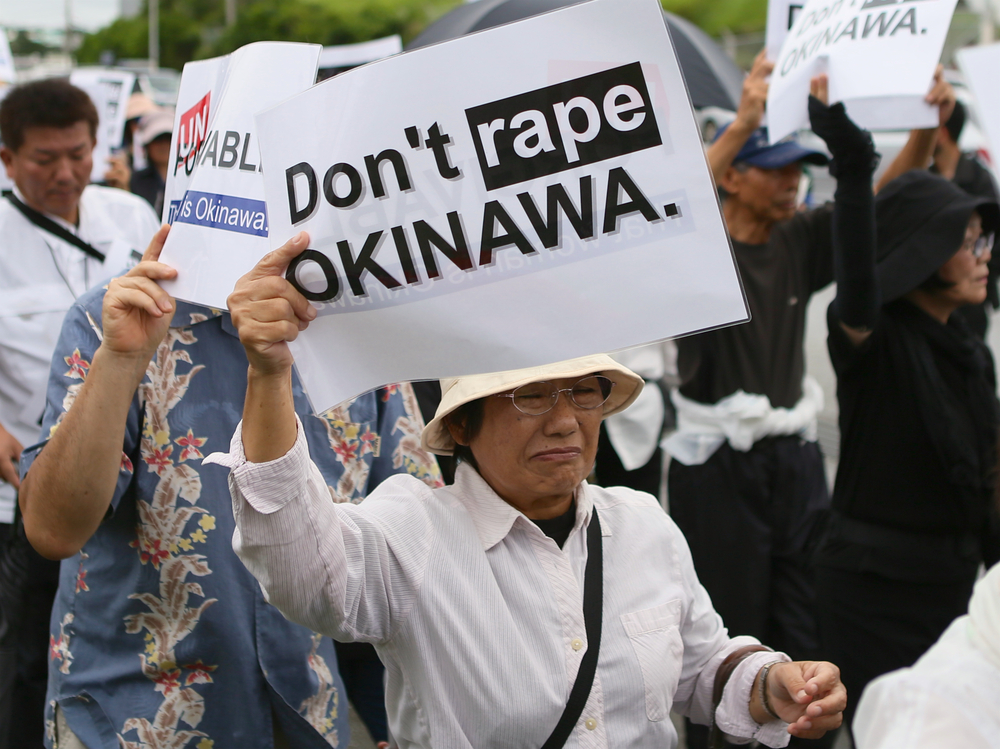by Jon Letman
In Akemi Johnson’s Night in The American Village: The Women in the Shadow of the U.S. Military Bases in Okinawa, the author presents a nuanced, dynamic study of gender, race, culture, and politics on the island where the United States maintains over half of the 57,000 troops it has stationed in Japan.
Each of the book’s eleven chapters is named for a woman—Sachiko, Suzuyo, Ashley, Daisy, Rina, and so on—each with stories of life (and death) in heavily militarized Okinawa.
Johnson, who spent extended periods conducting research in Okinawa between 2003–2017, explores how 74 years of U.S. military presence has impacted Okinawan society, particularly its women.
This study dates back to Japan’s annexation of the Ryukyu kingdom in the 1870s, which robbed the islands of their political sovereignty and set the stage for the unimaginably brutal Battle of Okinawa (April-June 1945), followed by U.S. control until 1972.
Through the experiences of women, Johnson details how both Tokyo and Washington used Okinawa to advance their own causes, always relying on Okinawa to shoulder the burden of a disproportionately large U.S. military presence that cements the U.S.-Japan alliance.
Caught in the middle, of course, are the Okinawans themselves, especially the women. Johnson recounts decades of sexual violence—murder, rape, unreported assaults, and abandonment. But she also meets women who have grown to live alongside the military, work together on bases, forge positive relationships, and start families.
Unexpected alliances form between women in Okinawa (local and foreign) and African-American military men with whom women report an affinity, saying they are treated more respectfully by black soldiers than whites for they share an experience of oppression by the more dominant population.
The author takes readers inside the U.S. bases (spacious and green) and outside (crowded and concrete), to the site of daily anti-base construction protests, and into clubs and bars where some soldiers and women seek each other out. Together they create a hybrid “chanpuru culture”—the name of the ubiquitous mixed stir-fry dish—fueled by conflict, companionship, and an uneasy history rooted in war.
Jon Letman: Your book examines Okinawans, mainland Japanese, and foreigners. What does Okinawa mean to each?
Akemi Johnson: In terms of Okinawans, viewpoints vary, but some people really see it as separate from Japan. When they talk about Japan, they’re talking about somewhere else, not Okinawa. Some people even advocate for independence. Others really have come to see Okinawa as this mixed place, what locals call chanpuru culture, a “mixed culture.”
To many mainland Japanese, Okinawa is like a tropical getaway — the Hawaii of Japan. Actually, for a lot of U.S. service members stationed on the island, there can also be that same view of Okinawa. I attended an orientation for [newly arrived] service members on the island and I was surprised to see that was an angle that was pushed, this idea of Okinawa as a vacation spot, a paradise… I think that’s strategically to boost morale.
You write about a cycle of self-defeat in which bars and clubs frequented by U.S. soldiers encourage excessive drinking which can lead to crimes that sometimes erupt into international incidents that, in turn, may result in soldiers losing “liberty” privileges and being confined to their base, only to have the cycle repeat itself later. You even described a bar that serves a strong cocktail called the “International Incident.” How can this cycle be broken?
At that orientation I attended, alongside this message of Okinawa as paradise, there was another conflicting message that this is an extremely loaded situation where any small action—a crime or incident by one individual—can blow up into an international incident and have ramifications on the U.S.-Japan security alliance. There is incredible pressure on service members to act responsibly, and not do stupid things, commit crimes.
But I’m not really sure how that message is getting across because obviously there are still incidents happening. The question is how do you really stop this cycle? It seems like what’s happening now is not working. I think a lot of locals (Okinawans) have come to the conclusion that the only way to really stop the cycle is to close the bases and remove the service members from the island.
Can you describe how the U.S. military incentivizes working on bases for Okinawans, Japanese, and other nationals, including former members of the military?
One reason is that Okinawa is the poorest prefecture in Japan, so I think more than other places in Japan, working on base is very attractive because the pay is relatively good and it’s seen as a stable, well-paying job for many people.
But I think another part is, if you grow up alongside a base and there’s this fence and you can never cross the fence, the ability to finally go to the other side every day [has] an allure for a lot of people to go where was previously off limits and also access all the base has to offer—the gym, the movie theater, the cheap American goods sold at the PX. Those have a lot of cachet to many local people.
Also, some people told me they just prefer an American work environment. They see it as more relaxed than a Japanese work environment. Women told me too that they felt like it’s a more equitable workplace, more gender-balanced than a Japanese workplace.
For retired U.S. service members, the base is also attractive. They can get on-base contractor jobs and never have to leave. They don’t have to learn the local language, they can work in English, and have these stable, relatively well-paying jobs they couldn’t have elsewhere in Japan. It allows them to stay on the island.
Can you talk about how different generations of Okinawans perceive the U.S. military presence?
The older generations experienced the war and U.S. occupation first-hand. Many of them are really motivated by a desire for peace and demilitarization. They say they know the horrors that a military can enact on the people. And they experienced the genesis of the bases and how this land was taken by “bulldozer and bayonet.”
Young people, of course, didn’t live through that, but they also don’t learn about it in school under the national curriculum. Maybe they learn a little bit about the war, but they don’t actually study the whole U.S. occupation-reversion movement, so the past seven decades of their island they don’t know about. To them, the bases were always there and it’s normalized to them.
Then there’s the more logistical factor that older people are the ones who have the time to protest, they’re retired. Because Okinawa is the poorest prefecture too, maybe young people are even more consumed with work and needing to make a living and they don’t have time to protest.
There’s also this phenomenon where a lot of people are afraid to speak about base issues. They see them as taboo and they’re really afraid of offending someone. Younger people might have to worry about their employer or their neighbors that they don’t want to offend, whereas older people feel more liberated and do not worry about what other people think.
Do you think that’s by design? Is there a thought that if they just wait, the resistance is going to die out eventually—10, 20, 30 years from now— because it’s going to be so normalized that no one will question it once the elders are gone?
Yes, I think so. I definitely heard that expressed—that it’s just a matter of time. Talking to Prof. Manabu Sato, who is from mainland Japan, he was shocked his Okinawan students didn’t know a thing about the history. He said if they don’t learn about it, the [demilitarization] movement is going to die out because they’re not going to care.
The United States and Japan frame Okinawa’s large military presence in terms of safety and security for the entirety of Japan. Do you think the long-term well-being and security of Okinawa is what motivates Tokyo or Washington?
Uhm, no. No, it’s pretty clear that’s not the case. It seems to be the general attitude that Okinawa needs to be sacrificed for the greater good, the greater security of the region. But I think movements like [activist] Suzuyo Takazato, these women’s movements are asking: “What is genuine security? Whose security are we talking about?” Certainly, for a lot of women who live around these bases, their lives are not safer and more secure because of these bases. They’re more endangered.
It seems there is a low level of interest in or understanding of Okinawa among most Americans, including members of Congress who are supposed to have some degree of oversight of military affairs. Would you agree with that assessment and, if so, how can it be changed?
I would say that for the majority of American public, and even members of Congress, this is not on their radar or something they are concerned about. This is a question Okinawan leaders and activists have been struggling with for years—how do you get people to care and understand the situation. I don’t think there’s an easy answer. My hope is that stories like the ones in my book will reach more people and bring to life this place and the situation and get people to care.
This conversation was edited for clarity and length. Night in The American Village: The Women in the Shadow of the U.S. Military Bases in Okinawa (The New Press) will be published on June 18. Jon Letman is an independent journalist in Hawaii, covering wildlife conservation





